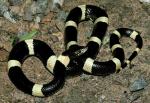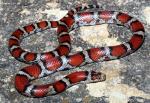|
|

|
LONG-NOSED SNAKE
Rhinocheilus lecontei
|
|
DESCRIPTION:
This snake can grow to 1,520 mm but in Arizona most individuals are less than 890 mm or 35" in total length. The head is narrow, the lower jaw is countersunk, and, in profile, the snout is pointed.
|

|
Lampropeltis getula holbrooki - Speckled Kingsnake
|
|
Geographic range
It is found in the central to southern United States from southern Iowa to the Gulf of Mexico.[1] Its range overlaps that of the desert kingsnake, Lampropeltis getula splendida, and it is known to intergrade with that subspecies.
|

|
Lampropeltis getula splendida - Desert Kingsnake
|
|
DESCRIPTION:
The Desert Kingsnake (Lampropeltis getula splendida) is a subspecies of kingsnake native to Texas, Arizona and New Mexico. It is nonvenomous, colored yellow and black. The desert kingsnake's diet consists of rodents, lizards, and smaller snakes, including rattlesnakes.
|

|
Lampropeltis triangulum - Milksnake
|
|
DESCRIPTION:
The milk snake or milksnake, Lampropeltis triangulum, (French: Couleuvre tachetée; Spanish: Culebra-real coralillo; Lithuanian: Pieninė gyvatė) is a species of king snake. There are 25 subspecies of milk snakes, including the commonly named scarlet kingsnake (L. t. elapsoides).
|

|
Lampropeltis triangulum syspila - Red Milksnake
|
|
Description
The Red Milk Snake is a tri-colored snake with broad red saddle-shaped markings bordered with black separated by pale bands. There are usually between 19 and 30 red or red-brown saddle shaped blotches edged with black, these blotches extend down the sides.
|

|
Liochlorophis (Opheodrys) vernalis - Smooth Greensnake
|
|
DESCRIPTION:
The smooth green snake (Opheodrys vernalis) is a nonvenomous North American colubrid. It is also referred to as the grass snake. It is a slender, "small medium" snake that measures 36–51 cm (14–20 in) as an adult.
|
|
|